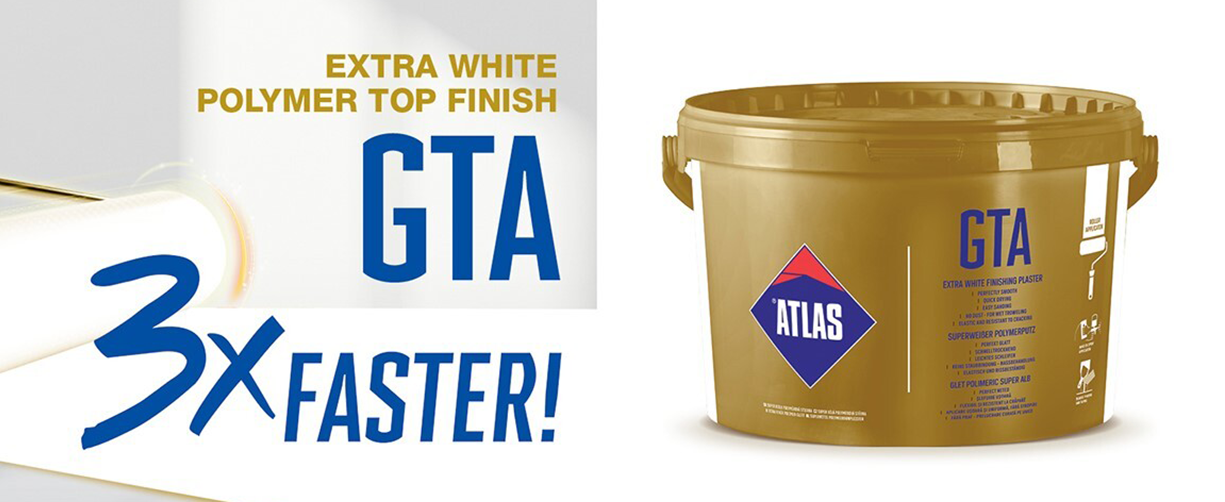Ready-mixed ATLAS GTA polymer finish plaster – test report

Preparation of the mass
The test began with preparing the material. The mass was mixed mechanically using a basket mixer, which prevents aeration of the product. For the contractor, the consistency was great and did not require dilution - the mass applied very well to the roller and stuck to the tool. The expert noticed the shape of the packaging - ATLAS GTA is a plaster packed in oval buckets. This allows you to easily scoop the mass directly from the packaging using rollers up to 25 cm long.
First layer
The plaster was applied to the surface directly from the bucket in a thin layer using a long-pile paint roller (11 mm long polyamide bristles). At the beginning, the tool with the collected material had to be "accelerated" - a few long, vertical movements on the ground were enough. Then the actual application began - the work progressed quickly! The applied layer immediately had an even thickness, which further shortened the duration of the works.
The contractor noted the ease of spreading and lack of splashing of the ATLAS GTA plaster. The mass did not drag behind the tool or drip from it.
Another advantage of this method is that there is no need to bend down into the bucket - the use of a roller mounted on a telescopic pole makes the work less tiring and comfortable. After spreading the mass on the substrate, the contractor began smoothing it using a wide putty knife. Already during the first layer, the contractor noted that it smoothed very well, pointing to the excellent working parameters of the ATLAS GTA plaster. Its open time is extended, which ensures smooth work progress. Even if it dries out slightly, you can add a little bit of mass with a roller and go back to smoothing. This is great comfort for the working person.
Quick! Faster! GTA!
Adapting the recipe to application with a roller is one of many features of the ATLAS GTA plaster that can speed up the progress of finishing works.
In addition, the mass allows for:
Dust-free wet smoothing ATLAS GTA can be subjected to wet processing (so-called dust-free grinding). The dried layer is sprayed with water and smoothed using a sponge trowel/trowel with a rubber sponge, which eliminates the dust-generating work step. This is especially important when we plan to apply the finishing layer in an already furnished apartment.
Wet-on-wet technology The second layer of ATLAS GTA plaster can be applied just 2 hours (this time depends on temperature and humidity) after applying the first one after initial setting and matting. This can shorten the duration of work by 50%!
Second layer
The second layer was applied after the first one was completely dry. The product was applied with a roller. Distribution was very easy and, importantly, there was no reduction in open time. This is undoubtedly an advantage of plasters intended for roller application. Due to the optimal adhesion of the product, there was no removal of the previously applied mass. Importantly, the surface was free from bubbles and other possible defects resulting from the nature of the substrate. Smoothing was just as easy as with the first layer.
Grinding
The applied method of application with a roller and smoothing with a plaster knife skimming spatulaguarantee a very even surface of the plaster, which minimizes the effort normally put into the next stage of work, which is grinding.
However, the surface should be subjected to final processing to remove minor errors and irregularities. We started with hard-to-reach places that were treated with an abrasive block. The wall surface was mechanically sanded using sandpaper.
This stage of work on uneven surfaces - which happens with the classic trowel application method - is considered the most labor-intensive. Especially when the plaster used is hard and processing was started after a long time after application.
Grinding ATLAS GTA is very easy due to the optimally selected hardness. There were no scratches or glazing on the surface.
Moreover, the resulting dust was heavy. It falls down, didn't float around the room or stay on the wall, which is important when painting.
The final effect obtained - a very smooth wall in a snow-white color.
Painting
Acrylic and latex paints generally have good adhesion to polymer finishes. However, sometimes a too smooth surface does not allow them to stick properly. In the case of ATLAS GTA, the surface was perfectly prepared for the final stage of work - the optimal size of fillers makes it very smooth and the roller does not slip on it.
Source:
Atlas.com.pl







